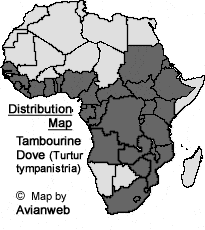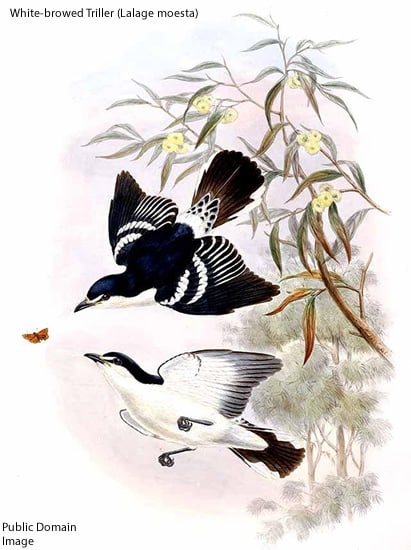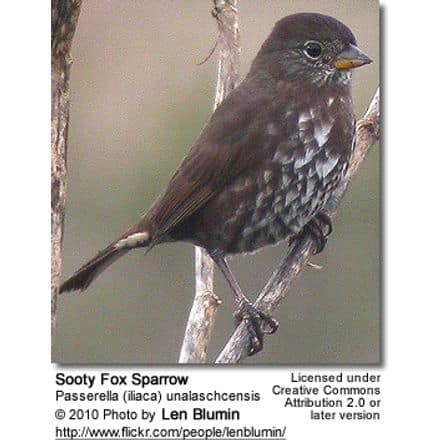Tambourine Doves (Turtur tympanistria)
The African Tambourine Wood Doves (Turtur tympanistria) are also known as Forest Doves, South African Tambourine Doves, Tambourine Doves, West African Tambourine Doves, White-breasted Wood Doves or White-breasted Pigeons.
They were formerly placed into their own genus tympanistria; and the populations north of the rivers Cunene in southern Angola and Zambezi were formerly separated in race fraseri.
Notwithstanding notable physical differences, they share sufficient similarities with the other members of the genus Turtur, in terms of vocalizations, behavior patterns and plumage / physical characteristicts to warrant inclusion in genus Turtur – the Wood Doves.
Distribution / Habitat
Tambourine Doves are at home in central and southern Africa; where they occur in the countries of Senegal and Gambia east to coastal West Africa – Ethiopia, southern Somalia, south through central and eastern Africa to South Africa. They are absent from the drier areas of south-western Africa.
They are also native to the island of Bioko (traditionally called Fernando Pó) – an island off the west coast of Africa; and Comoro Islands – islands situated off the south-east coast of Africa.
They inhabit dense forests and other areas with thick vegetation, including suitable gardens and plantations of castor oil, cocoa and rubber. They usually remain near bodies of water, such as rivers, lakes and dams. They are resident (non-migratory) with their range.
These pigeons are usually seen alone or in pairs, but may form large flocks at waterholes or at favored feeding areas.
Further Dove Information
- Dove Information
- Index of Dove Species
- Photos of the Different Dove Species for Identification
- Doves & Pigeons as Pets
Description
Tambourine Doves are small plump pigeons that generally measure 8.7 – 9 inches (22 – 23 cm) in length – including the tail; and weigh about 2.5 oz (72 grams).
Males have grey crown, white faces with a black spot behind each eye, white throats and white underparts. Their backs, hind necks, wings and tails are grey brown. Large dark purple patches can be seen on the folded wings. The tail below is brown. The eye rings, legs and feet are purplish- red. The bills are purple. The eyes (irises) are brown.
Flight: Their flight is quick and characterized by regular beats and occasional sharp flicks of the wings; and they generally fly low. In flight, the chestnut markings in the underwings are visible.
Gender ID: Females have a duller plumage with grey-brown crowns, pale-brown faces and chests, and white bellies.
Juveniles resembles the females except for chestnut fringes to the feathers of the back, chest and flanks.
Nesting / Breeding
Pairs are monogamous, establishing firm bonds that last a lifetime. They build nests out of twigs, leaves and other plant matter. Their nests are found high up in trees where they are well hidden in foliage. The average clutch consists of 1 – 2 cream-colored eggs. The male and female raise the young jointly to independence.
Diet / Feeding
Tambourine Doves mostly feed on various seeds, fruits and insects. Most foraging occurs on the ground and low down in the shrubs; however, they may also pick up food in the tree foliage.
Calls / Vocalizations
Their calls are described as a persistently repeated du-du-du-du-du.
Sound Recordings / Sound Recordings 2
Alternate (Global) Names
Afrikaans: Witborsduifie … Chinese: ???? … Czech: Hrdlicka bubínková, hrdli?ka bubínková … Danish: Tamburindue … Dutch: Tamboerijnduif … Estonian: tamburiintuvi … Finnish: Tamburiinikyyhky … French: Colombe tambourette, Colombe tambourine, Tourtelette tambourette, Tourterelle tambourette, Tourterelle tambourine, Tourterelle tambourinette … German: Tambourintäubchen, Tambourintaube, Tamburintaube … Italian: Tortora tamburina … Japanese: tambarimbato, tanbarinbato … Norwegian: Latterdue, Tamburindue … Polish: turkaweczka bialoczelna, turkaweczka bia?oczelna … Portuguese: Rola-de-papo-branco … Russian: ?????????? ???????, ?????????? ?????? ???????, ?????????? ??????? … Slovak: bronzovka bubeník , Hrdli?ka tamburínová … Spanish: Paloma Tamborilera, Palomita Tamborilera … Swahili: Pugi-kikombe … Swedish: Tambourinfläckduva … Tsonga: Xiwambalane … Xhosa: Isavu … Zulu: isiBhelu






